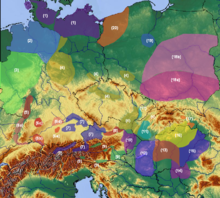Únětice culture
 |
|
| Geographical range | Europe |
|---|---|
| Period | Bronze Age Europe |
| Dates | c. 2300 – c. 1600 BCE |
| Type site | Únětice |
| Preceded by | Beaker culture |
| Followed by | Tumulus culture |
|
Bronze Age |
|---|
| ↑ Chalcolithic |
|
Near East (c. 3300–1200 BC) South Asia (c. 3000– 1200 BC) Europe (c. 3200–600 BC)
China (c. 2000–700 BC) |
| ↓Iron Age |
Near East (c. 3300–1200 BC)
South Asia (c. 3000– 1200 BC)
Europe (c. 3200–600 BC)
China (c. 2000–700 BC)
arsenical bronze
writing, literature
sword, chariot
The Únětice culture (Czech pronunciation: [ˈuːɲɛcɪt͡sɛ], Czech Únětická kultura, German Aunjetitzer Kultur, Polish Kultura unietycka) is an archaeological culture at the start of the Central European Bronze Age, dated roughly to about 2300–1600 BC. The eponymous site for this culture, the village of Únětice, is located in the central Czech Republic, northwest of Prague. Today, this archaeological culture is known from Czech Republic and Slovakia from about 1,400 sites, from Poland (550 sites) and Germany (about 500 sites and loose finds locations). The Únětice culture is also known from north-eastern Austria (in association with the so-called the Böheimkirchen Group), and from western Ukraine.
The Únětice culture originated in the territories of contemporary Bohemia. Ten local sub-groups can be distinguished in its classical phase:
The Únětice culture was discovered by Czech surgeon and amateur archaeologist Čeněk Rýzner (1845-1923), who in 1879 found a cemetery of over 50 inhumations on Holý Vrch, the hill overlooking the village of Únětice. At the same time the first Úněticean burial ground was unearthed in Southern Moravia in Měnín by A. Rzehak. Following these initial discoveries and until the nineteen thirties, many more sites, primarily cemeteries, were identified, e.g. Němčice nad Hanou (1926), sites in vicinity of Prague, Polepy (1926–27) or Šardičky (1927).
...
Wikipedia
